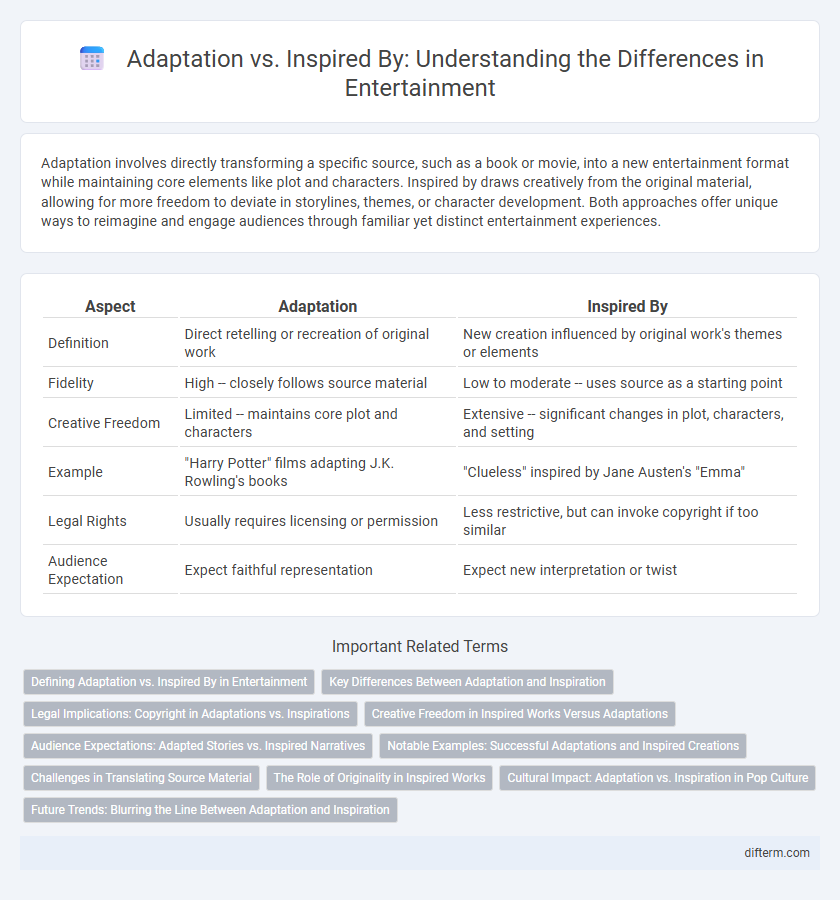Adaptation involves directly transforming a specific source, such as a book or movie, into a new entertainment format while maintaining core elements like plot and characters. Inspired by draws creatively from the original material, allowing for more freedom to deviate in storylines, themes, or character development. Both approaches offer unique ways to reimagine and engage audiences through familiar yet distinct entertainment experiences.
Table of Comparison
| Aspect | Adaptation | Inspired By |
|---|---|---|
| Definition | Direct retelling or recreation of original work | New creation influenced by original work's themes or elements |
| Fidelity | High -- closely follows source material | Low to moderate -- uses source as a starting point |
| Creative Freedom | Limited -- maintains core plot and characters | Extensive -- significant changes in plot, characters, and setting |
| Example | "Harry Potter" films adapting J.K. Rowling's books | "Clueless" inspired by Jane Austen's "Emma" |
| Legal Rights | Usually requires licensing or permission | Less restrictive, but can invoke copyright if too similar |
| Audience Expectation | Expect faithful representation | Expect new interpretation or twist |
Defining Adaptation vs. Inspired By in Entertainment
Adaptation in entertainment involves the direct transformation of an existing work into a new medium, maintaining core story elements, characters, and plotlines, such as a novel turned into a film. Inspired by, however, refers to content that draws creative influence from original works but diverges significantly in narrative or style, allowing for greater artistic freedom. Understanding this distinction is crucial for intellectual property rights, audience expectations, and creative processes within film, television, and theater industries.
Key Differences Between Adaptation and Inspiration
Adaptation involves directly transforming an original work into a new format, maintaining core elements such as plot and characters to preserve the source's essence in films, TV shows, or theater. Inspiration allows creators to draw ideas or themes loosely from an original work, resulting in a new piece that may significantly differ in storyline, setting, or character development. Key differences include fidelity to the original material, with adaptations prioritizing accuracy and inspiration emphasizing creative freedom.
Legal Implications: Copyright in Adaptations vs. Inspirations
Legal implications of adaptations hinge on obtaining explicit copyright permissions to reproduce or closely mirror the original work's protected elements, whereas inspirations typically require less stringent clearance as they involve transformative uses that do not replicate copyrighted expression. Adaptations often trigger licensing agreements, royalties, and potential litigation if rights are infringed, while works inspired by others avoid direct infringement claims by incorporating original creativity and new expression. Courts assess substantial similarity and derivative work criteria to differentiate unlawful adaptations from legal inspirations within copyright law frameworks.
Creative Freedom in Inspired Works Versus Adaptations
Inspired works in entertainment offer greater creative freedom by allowing creators to reinterpret themes, characters, and settings without strict adherence to the original source. Adaptations require fidelity to established narratives and often face limitations imposed by fans' expectations and intellectual property rights. This flexibility in inspired works enables innovative storytelling that can diverge significantly while still resonating with the essence of the original material.
Audience Expectations: Adapted Stories vs. Inspired Narratives
Audiences expect adapted stories to closely follow the original source material, preserving key plot points, characters, and themes to deliver a familiar experience. Inspired narratives offer creative freedom, allowing storytellers to reinterpret or expand upon a concept, often resulting in fresh perspectives that surprise the audience. Understanding these expectations helps creators balance authenticity and innovation, ensuring engagement and satisfaction among fans of the original work.
Notable Examples: Successful Adaptations and Inspired Creations
Notable examples in entertainment distinguish successful adaptations like "The Lord of the Rings" film trilogy, which faithfully translates J.R.R. Tolkien's novels to screen, from inspired creations such as "Blade Runner," which draws loosely from Philip K. Dick's "Do Androids Dream of Electric Sheep?" to craft an original narrative. Adaptations prioritize preserving core characters, plotlines, and themes, ensuring audience recognition and loyalty, while inspired works reinterpret foundational concepts to explore new artistic directions. The success of adaptations like "Harry Potter" contrasts with inspired successes like "Westworld," revealing varied approaches to storytelling influence.
Challenges in Translating Source Material
Adapting source material requires maintaining narrative fidelity while reimagining elements for a new medium, often creating challenges in balancing original themes with audience expectations. Inspired-by works allow more creative freedom but risk losing the essence that made the source compelling, potentially alienating fans. Successful adaptation hinges on preserving core story arcs, character development, and cultural nuances amid structural changes.
The Role of Originality in Inspired Works
Inspired works draw upon original source material while infusing unique creativity, allowing storytellers to explore new perspectives without being confined to direct adaptation. This approach fosters innovation by blending familiar elements with original themes, characters, or settings, enriching the entertainment landscape. Balancing homage and originality in inspired works maintains audience engagement and honors the essence of the original while offering fresh narratives.
Cultural Impact: Adaptation vs. Inspiration in Pop Culture
Adaptations closely replicate source material, preserving original narratives and cultural nuances, which strengthens audience connection and cultural preservation. Inspired works reinterpret themes and characters, sparking creativity and fostering new cultural expressions that reflect contemporary values. Both approaches significantly influence pop culture by shaping identity, expanding representation, and driving media evolution.
Future Trends: Blurring the Line Between Adaptation and Inspiration
Future trends in entertainment reveal a growing fusion between adaptation and inspiration, where original source materials serve as frameworks rather than strict blueprints for new creations. Advanced technologies like AI-driven storytelling and interactive media enable creators to blend elements from various narratives, resulting in content that transcends traditional adaptation boundaries. This shift fosters innovative experiences that resonate with diverse audiences by offering fresh perspectives while honoring original themes.
adaptation vs inspired by Infographic

 difterm.com
difterm.com